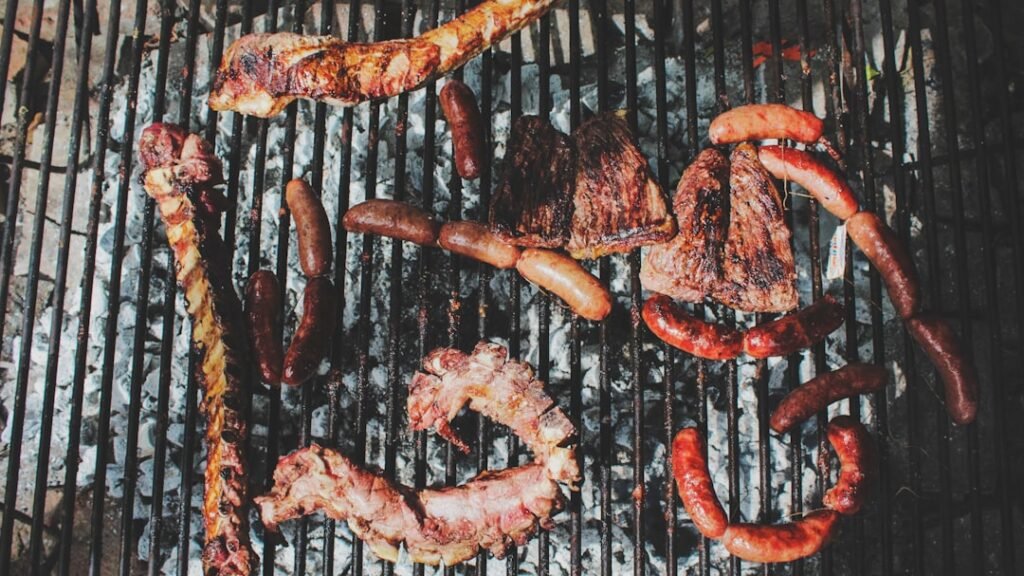Mastering the Art of Barbecuing: Tips for Perfect Grilling

When it comes to grilling, one of the most significant decisions I face is whether to choose a gas or charcoal grill. Each type has its own unique advantages and disadvantages, and my choice often depends on the occasion and my personal preferences. Gas grills are known for their convenience and ease of use.
With just the turn of a knob, I can ignite the flames and start cooking almost immediately. This is particularly appealing when I’m short on time or when I want to grill something quickly for a spontaneous gathering. The temperature control on gas grills is also more precise, allowing me to adjust the heat with ease, which is crucial for achieving that perfect sear on a steak or maintaining a steady temperature for slow-cooking ribs.
On the other hand, charcoal grills offer a distinct flavor that many enthusiasts, including myself, find hard to resist. The smoky aroma that wafts through the air as the charcoal ignites is an integral part of the grilling experience. Charcoal grilling requires a bit more effort and patience, as I need to wait for the coals to reach the right temperature before I can start cooking.
However, this process allows me to engage more deeply with the food and the fire, creating a more immersive experience. Additionally, charcoal grills often come with a lower price tag compared to their gas counterparts, making them an attractive option for those just starting their grilling journey.
Marinades are an essential component of my grilling repertoire, as they infuse meat with flavor and tenderness. The process of creating a marinade is both an art and a science, allowing me to experiment with various ingredients to achieve the desired taste profile. A basic marinade typically consists of an acid, such as vinegar or citrus juice, which helps to tenderize the meat; oil, which adds moisture; and a combination of herbs and spices for flavor.
I often find myself reaching for ingredients like garlic, soy sauce, and fresh herbs to create a well-rounded marinade that complements the natural flavors of the meat. Once I’ve prepared my marinade, I make sure to let the meat soak in it for at least a few hours, if not overnight. This allows the flavors to penetrate deeply, resulting in a more flavorful dish.
I also pay attention to the type of meat I’m marinating; for instance, tougher cuts like flank steak benefit from longer marination times, while more delicate proteins like chicken breasts may only need a couple of hours. The key is to strike a balance between flavor and tenderness without overpowering the natural taste of the meat. By experimenting with different combinations of ingredients and marination times, I’ve discovered my own signature marinades that never fail to impress my guests.
Temperature Control and Cooking Times
Understanding temperature control is crucial for successful grilling, and it’s something I’ve learned through trial and error over the years. Each type of meat requires different cooking temperatures and times to achieve that perfect doneness. For instance, when grilling chicken, I aim for an internal temperature of 165°F (75°C) to ensure it’s safe to eat while remaining juicy and tender.
On the other hand, beef steaks can be cooked to varying degrees of doneness, from rare at 125°F (52°C) to well-done at 160°F (71°C). I often use a reliable meat thermometer to check the internal temperature, as it takes the guesswork out of grilling and helps me avoid overcooking. In addition to monitoring internal temperatures, I also pay attention to the heat zones on my grill.
Creating two zones—one for direct heat and another for indirect heat—allows me to sear meats quickly while also giving them time to cook through without burning. For example, I’ll sear a steak over high heat for a few minutes on each side before moving it to the cooler side of the grill to finish cooking gently. This technique not only enhances flavor but also ensures that my meats are cooked evenly throughout.
Essential Tools and Accessories for Barbecuing

Having the right tools and accessories can make all the difference in my grilling experience. Over time, I’ve accumulated a collection of essential items that enhance both convenience and safety while barbecuing. A good set of long-handled tongs is indispensable; they allow me to flip burgers or turn sausages without getting too close to the flames.
Additionally, a sturdy spatula is crucial for handling delicate items like fish fillets or grilled vegetables without them falling apart. Another tool that I find invaluable is a grill brush for cleaning grates before and after cooking. Keeping my grill clean not only ensures better flavor but also prolongs its lifespan.
I also invest in high-quality skewers for kabobs; metal skewers are reusable and prevent food from spinning around while cooking. Lastly, I always keep a spray bottle filled with water nearby to manage flare-ups caused by dripping fat or marinades. These tools have become staples in my grilling routine, making each barbecue session smoother and more enjoyable.
Tips for Grilling Vegetables and Seafood
| Vegetable/Seafood | Preparation | Grilling Time | Grilling Tips |
|---|---|---|---|
| Asparagus | Trim ends, toss in olive oil | 5-7 minutes | Grill over medium heat, turn occasionally |
| Zucchini | Slice, brush with oil and seasonings | 4-6 minutes | Grill on high heat for grill marks |
| Salmon | Season with salt, pepper, and lemon | 4-6 minutes per side | Use a fish basket for easy flipping |
| Shrimp | Toss in garlic, lemon, and olive oil | 2-3 minutes per side | Use skewers for easy grilling |
Grilling vegetables and seafood presents its own set of challenges and rewards, and I’ve learned some valuable tips along the way. When it comes to vegetables, I often choose those that hold up well on the grill, such as bell peppers, zucchini, and asparagus. To prevent them from falling through the grates, I cut them into larger pieces or use a grill basket.
Marinating vegetables before grilling not only adds flavor but also helps them retain moisture during cooking. For seafood, timing is everything. Fish fillets can cook quickly, so I make sure to keep an eye on them to avoid overcooking.
A good rule of thumb is to cook fish for about 8-10 minutes per inch of thickness. I also find that using skin-on fillets helps keep the fish intact while grilling. Additionally, brushing seafood with oil or marinade before placing it on the grill helps prevent sticking and enhances flavor.
By following these tips, I can create delicious grilled vegetable and seafood dishes that complement my meat offerings beautifully.
Mastering the Art of BBQ Sauce
No barbecue is complete without a delicious sauce to accompany it, and mastering BBQ sauce has become one of my favorite culinary pursuits. There are countless regional variations of BBQ sauce—some are tangy and vinegar-based, while others are thick and sweet with molasses or brown sugar. I enjoy experimenting with different ingredients to create my own signature sauce that reflects my taste preferences.
A basic BBQ sauce typically includes ketchup as a base, combined with vinegar, sugar, mustard, and spices. One of my favorite techniques is to start with a simple base sauce and then customize it by adding unique ingredients like chipotle peppers for heat or honey for sweetness. As I simmer the sauce on low heat, I allow the flavors to meld together beautifully.
It’s important for me to taste as I go along; this way, I can adjust the seasoning until it’s just right. Once perfected, I love slathering my homemade BBQ sauce on ribs or using it as a dipping sauce for grilled chicken wings.
Safety Tips for Grilling Outdoors

Grilling outdoors can be a delightful experience, but safety should always be my top priority. One of the first things I do before firing up the grill is ensure that my cooking area is clear of any flammable materials such as paper towels or propane tanks stored too close to the heat source. If I’m using a gas grill, I check for leaks by applying soapy water to connections; if bubbles form, it indicates a leak that needs immediate attention.
I also make sure to have a fire extinguisher nearby in case of emergencies. When handling raw meat, I practice good hygiene by washing my hands thoroughly before and after touching it to prevent cross-contamination with other foods. Additionally, using separate cutting boards for raw meat and vegetables helps maintain food safety standards in my outdoor kitchen setup.
By following these safety tips diligently, I can enjoy grilling while minimizing risks.
Perfecting the Art of Barbecue Presentation
After all the hard work put into grilling delicious food, presentation plays a crucial role in elevating the dining experience. I believe that how food looks can significantly enhance its appeal; therefore, I take time to arrange everything thoughtfully on platters or plates before serving. For meats like ribs or brisket, slicing them neatly and arranging them in an appealing manner can make all the difference in how they are perceived by guests.
I also enjoy garnishing dishes with fresh herbs or colorful vegetables to add visual interest. For instance, placing grilled corn on skewers alongside vibrant bell peppers creates an eye-catching display that invites people to dig in. Additionally, serving sauces in small bowls allows guests to customize their meals according to their preferences while adding an element of sophistication to the table setting.
By focusing on presentation as much as flavor, I ensure that my barbecues are memorable experiences for everyone involved. In conclusion, grilling is not just about cooking; it’s an art form that encompasses various techniques and considerations from choosing the right grill type to perfecting presentation skills. Each step along this journey contributes to creating delicious meals that bring people together around the fire—a tradition that continues to thrive in backyards across America and beyond.






